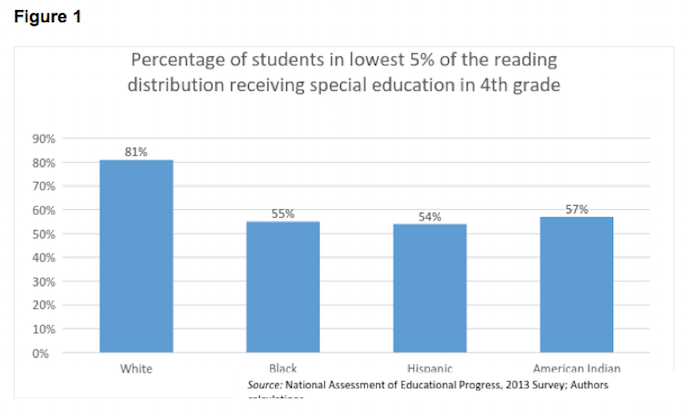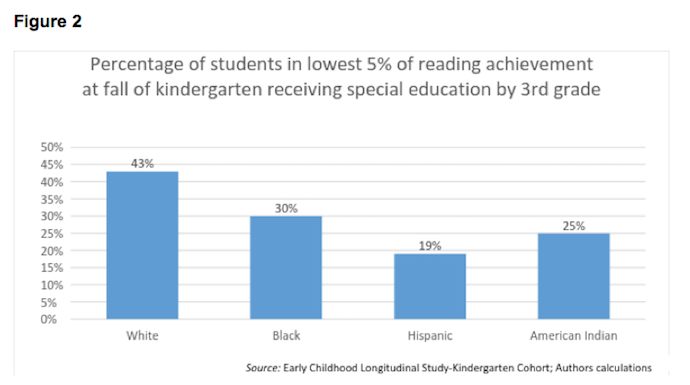Are U.S. schools widely over-identifying children as disabled based on their race or ethnicity? Congress, the U.S. Department of Education, and many scholars think so. They are well-intentioned but wrong.

The best-available empirical studies repeatedly find that the opposite is occurring. White children are much more likely than otherwise similar racial and ethnic minority children to receive special education services in the U.S. Ensuring equity in the Individuals with Disabilities Education Act (IDEA) means making sure all children with disabilities are able to access the services to which they have a civil right.
In both 1997 and 2004, Congress amended the Individuals with Disabilities Education Act (IDEA) to require states to monitor and report the extent to which minority children are over-represented in special education. In 2016, the U.S. Department of Education proposed a new set of regulations, termed Equity in IDEA, that would expand these requirements. States would now be required to use a standard methodology for comparing racial and ethnic groups and to use quota-like “reasonable thresholds” allowed by the Department for determining when minorities are over-represented.
Although these amendments and regulations have assumed that minority over-representation is occurring because of widespread misidentification based on race or ethnicity, the underlying empirical work was not properly designed to investigate whether this was the case. The prior work mostly has been limited to reporting on the relative proportions of minority children in the general school age and special education populations. For example, the U.S. Department of Education recently reported that black children represent 14% of the general school-aged population but 19% of the special education population.
Yet such reporting simply does not allow us to know whether minority over-representation in special education is explained by racial discrimination. The disparities may have many other possible explanations. For example, black children are disproportionately over-represented among recipients of both Title 1 and Head Start. It does not necessarily follow that the programs are discriminatory. The services are being provided to help children who are economically disadvantaged to better succeed in school, and a disproportionate number of these children are racial or ethnic minorities. For example, 40% of black children but only 10% of white children live in poverty.
As is the practice in both economics and public health, and as explained by an expert panel of the National Research Council, strong evidence of racial discrimination through educational research requires “apples to apples” contrasts between otherwise similar children. Finding that, amongst otherwise similar children, those who are racial or ethnic minorities are more likely to be identified as disabled would provide strong evidence of racial bias. This is because other possible explanations (e.g., minority children’s greater exposure to poverty, their greater likelihood of experiencing academic difficulties) have been taken into account.
We have been conducting these types of comparisons for over six years. The comparisons statistically control for children’s exposure to poverty, academic achievement, gender, history of low birthweight, lack of health insurance, non-English language use, and many other potential confounds. Low academic achievement is particularly important to control for because children only receive special education services if their disabilities are adversely affecting their educational performance. Because of the rigor of our statistical controls, we approximate the condition in which the children are otherwise identical except in their race or ethnicity.
What we find is exactly the opposite of what many have assumed to be occurring, as well as what the Department’s regulations are mistakenly attempting to address. We repeatedly find that white children are more likely to be identified as having disabilities, and so more likely to receive special education services, than otherwise similar racial or ethnic minority children. Put another way, we find strong evidence that schools may be biased against identifying minority children with clinically significant needs as having disabilities.
We have repeatedly replicated this finding. We have found that white children are more likely to be identified as having disabilities than otherwise similar racial or ethnic minority children whether we (a) use parent- or teacher-report of disability status, (b) examine the time period before, at, or after school entry, or (c) examine special education generally or look at a wide range of specific disability conditions. We sometimes find that minority children are over-represented in special education before adjusting for potential confounds, but never after the confounds are controlled for.
We repeatedly find that children’s own reading and mathematics achievement are by far the most important predictors of whether they are identified as disabled. This makes sense. Once children’s own academic achievement is controlled, most other predictors, including their family’s socioeconomic status, often lose statistical significance. This makes sense too. We conclude that schools are largely providing special education services to children who are struggling academically.
The size of the disparities in special education service receipt between otherwise similar white and minority children are very large. For example, we find that white children have odds of being identified as intellectually disabled that are about 60% higher than for Black children experiencing the same levels of impairment. We find similarly large disparities in children’s likelihood of being identified as having learning disabilities, speech or language impairments, other health impairments, and emotional disorders.
Figure 1 helps illustrate our findings. Among U.S. fourth graders whose reading achievement was in the lowest 5% of the distribution—children who were all experiencing clinically significant and severe reading difficulties—over 80% of white children were receiving additional help through special education. In contrast, despite also experiencing severe reading difficulties, only 55%, 54%, and 57% of Black, Hispanic, and American Indian children were receiving special education services.

Figure 2 replicates this finding using still another nationally representative sample. Here we examine U.S. schoolchildren who all entered kindergarten at risk for severe reading difficulties. We find that 43% of white children were receiving special education services by third grade. The percentages for otherwise similar Black, Hispanic, and American Indian children were again far lower.

The findings are from different samples and time periods, yet they point to the same conclusion. Among children displaying the same clinical needs, white children are more likely to receive special education services than racial or ethnic minority children. In addition to being repeatedly replicated, our findings also are consistent with those reported by public health researchers. These researchers also find that white children are more likely than otherwise similar minority children to receive treatment for disabilities.
The wrong way to ensure equity in IDEA is by establishing quota-like systems designed to keep “too many” minority children from receiving additional services to which they may have a civil right. The right way to ensure equity in IDEA is to make sure that children with disabilities who are racial or ethnic minorities are able to access these services just as much as those who are white. The best-available empirical studies show again and again that this may not be occurring. All children with disabilities, regardless of their race or ethnicity, should be receiving our help.
What might we do? One possibility is to adopt universal screening as part of special education’s Child Find procedures. Right now, disability identification prior to or after entering school largely depends on parent- and teacher-referral. Universal, standardized screening has been proposed for addressing similar disparities in public health and gifted education. Ensuring that special education’s due process materials — including documents published by the state departments of education–are widely accessible should also help. Currently, about 95% of these materials require college-level schooling to be understood.
To properly monitor for equity in IDEA, the Department of Education must begin doing so in the methodologically correct way. This necessitates contrasting children who are otherwise similar in their clinical needs and, thus, potential risk for having disabilities. One possibility would be to begin using data from the National Assessment of Educational Progress to monitor for disproportionality across the U.S. These data allow for comparisons between children within states who are otherwise similar in their academic achievement as well as in other background characteristics. States and localities increasingly collect these type of data, which might be used as well.
To be truly effective, efforts to ensure equity in IDEA by Congress, the U.S. Department of Education, and education scholars require a correct empirical understanding of the types of inequities currently being experienced by minority schoolchildren. As has been found in gifted education, we find that white children are more likely to receive special education services than similarly achieving racial or ethnic minority children. All children with disabilities, regardless of their race or ethnicity, deserve the help that IDEA promises.
—Paul L. Morgan and George Farkas
Paul Morgan is a professor of education at Penn State and George Farkas is a professor of education at the University of California, Irvine. They were interviewed by Ed Next’s Marty West about their research in this week’s episode of the EdNext podcast.


